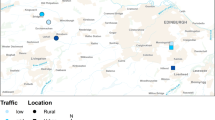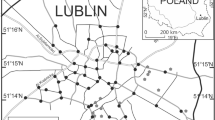Abstract
In recent years, the level of heavy metal pollution in urban areas has been of considerable concern. The principal source has been attributed to the motor vehicle and increasing inner city congestion, which has lead to a change and enlargement of transport stop–start zones. These areas of high traffic density are associated with an increased release of heavy metals into the adjacent residential or commercial areas. Seventy-five roadside dust samples were collected throughout the inner city and by-pass motorway areas of Thessaloniki, Northern Greece. Samples were taken from arterial, major and minor roads, as well as the ring road, to compare and contrast the levels of heavy metals, namely Cu, Zn, Cd, Mn and Pb. Flame Atomic Absorption Spectroscopy (FAAS) was developed to quantitatively determine concentrations of both total element and geochemical fractionation, within the two dust particulate fraction sizes <75 μm and 75–125 μm. Acid digestion using Aqua Regia (3:1 conc. HCl:HNO3) was employed for the total elemental analysis, a method that was validated through the use of certified reference materials (CRM). Fractionation studies involved a three-step sequential extraction method performed on five selected samples (representatives of high, mid and low total elemental concentrations). The resultant solutions were analysed for lead and zinc levels to ascertain fractionation throughout the different geochemical fractions, thus assessing bioavailability.
It was found that congestion/stop–start traffic patterns did influence and have led to increased levels of heavy metal deposition along inner city roads compared to levels observed on the new relief ring road. Dust particulate fraction sizes were only found to show statistically significant differences in cadmium and manganese, at the probability P < 0.001 or 99.9% confidence limit. Both Cd and Mn showed higher total levels in the smaller fraction sizes (<75 μm), implying that their major release source is exhaust emissions. There were no significant differences in the other elements, at the P > 0.05 or 95% confidence limit. Road type was seen to have little affect on cadmium and manganese, though lead, copper and zinc were all found to show higher levels on the inner city routes. This can be related back to the wear-and-tear of vehicle components as a result of the stop–start traffic patterns (brake pads etc). Both Pb and Zn have shown to be in chemical forms that are bio available to ecosystems.
Similar content being viewed by others
References
Anagnostopoulos, A. (1981). Lead in some streets in Thessalonica. In A. Anagnostopoulos (Ed.), Proceedings of first international conference of environmental pollution, 21–25 September (pp. 190–202). Thessaloniki, Greece.
Anagnostopoulou, M. A., & Day, P. J. (2006). Lead concentrations and isotope ratios in street dust in major cities in Greece in relation to the use of lead in petrol. The Science of the Total Environment, 367, 791–799. doi:10.1016/j.scitotenv.2006.01.040.
Charlesworth, S., Everett, M., McCarthy, R., Ordonez, A., & DeMiguel, E. (2003). A comparative study of heavy metal concentration and distribution in deposited street dusts in a large and a small urban area: Birmingham and Coventry, West Midlands, UK. Environment International, 29(5), 563–573. doi:10.1016/S0160-4120(03)00015-1.
Hares, R. J., & Ward, N. I. (2004). Sediment accumulation in newly constructed vegetative treatment facilities along a new major road. The Science of the Total Environment, 334–335, 473–479. doi:10.1016/j.scitotenv.2004.04.051.
Namdeo, A. K., Colls, J. J., & Baker, C. J. (1999). Dispersion and re-suspension of fine and coarse particulates in an urban street canyon. The Science of the Total Environment, 235(1–3), 3–13. doi:10.1016/S0048-9697(99)00185-0.
Rauret, G., Lopez-Sanchez, J. F., Sahuquillo, A., Rubio, R., Davidson, C., Ure, A., et al. (1999). Improvement of the BCR three step sequential extraction procedure prior to the certification of the new sediment and soil reference materials. Journal of Environmental Monitoring, 1, 57–61. doi:10.1039/a807854h.
Rayson, M. J. T. (1990). An investigation into the effects of vehicular pollution on the U.K. and North American environments. MSc. Dissertation. Department of Chemical Sciences, University of Surrey, UK.
Saryan, L. A., & Zenz, C. (1994). In C. Zenz, O. B. Dickerson, & E. P. Horvath (Eds.), Occupational medicine (3rd ed., pp. 330–472, 506–541, 632–755). UK: Mosby.
Sezgin, N. H., Ozcan, K., Demir, G., Nemlioglu, S., & Bayat, C. (2004). Determination of heavy metal concentrations in street dusts in Istanbul E-5 highway. Environment International, 29(7), 979–985. doi:10.1016/S0160-4120(03)00075–8.
Stead, K., Hares, R. J., & Ward, N. I.(2000). Sequential extractions, fractionation studies—what are they defining? In: J. Nriagu (Ed.), Eleventh annual international conference on heavy metals in the environment, University of Michigan, School of Public Health (pp. 1–27). Ann Arbor: J. Nriagu.
Tessier, A., Campell, P. G. C., & Bisson, M. (1979). Sequential extraction procedure for the speciation of particulate trace metals. Analytical Chemistry, 51(7), 844–851. doi:10.1021/ac50043a017.
Thorton, I. (1991). Metal contamination of soils in urban areas. In: P. Bullock & P. J. Gregory (Eds.), Soils in the urban environment (pp. 47–75). UK: Blackwell.
Ward, N. I., Dudding, A., & Lyndon, M. (2004). Platinum emissions and levels in motorway dust samples: Influence of traffic characteristics. The Science of the Total Environment, 334–335, 457–463. doi:10.1016/j.scitotenv.2004.04.049.
Xiangdong, L., Chi-sun, P., & Pui Sum, L. (2001). Heavy metal contamination of urban soils and street dusts in Hong Kong. Applied Geochemistry, 16(11–12), 1361–1368. doi:10.1016/S0883-2927(01)00045-2.
Author information
Authors and Affiliations
Corresponding author
Rights and permissions
About this article
Cite this article
Ewen, C., Anagnostopoulou, M.A. & Ward, N.I. Monitoring of heavy metal levels in roadside dusts of Thessaloniki, Greece in relation to motor vehicle traffic density and flow. Environ Monit Assess 157, 483–498 (2009). https://doi.org/10.1007/s10661-008-0550-9
Received:
Accepted:
Published:
Issue Date:
DOI: https://doi.org/10.1007/s10661-008-0550-9




